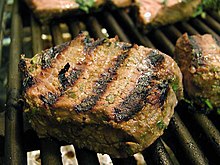Roasting (cooking)
Roasting is dry cooking over high heat. The Maillard reaction creates compounds of proteins , fats and sugars on the surface of the food , which are responsible for the browning and the typical taste. When frying vegetables with a low protein content, the Maillard reaction plays only a minor role, browning and aroma are mainly caused by caramelization .
Roasting is probably the oldest cooking technique, because it does not necessarily require vessels, only control of the fire.
In common parlance, grilling , roasting in the oven and open roasting in the pan (also called sautéing ) are summarized under roasting . However, there is an essential difference between grilling and roasting in the oven, on the one hand, in which heat radiation plays the main role, and, on the other hand, roasting in the pan, which is based on heat conduction. If liquid is added after frying , it is called braising .
Roast meat
When roasting meat , a suitable choice of temperature and duration must be taken to ensure that the crust that forms is aromatic but not too dark. At the same time, the inside has to reach a temperature at which the collagen in the connective tissue , which makes the meat tough, can turn into gelatin , but the muscle protein does not coagulate enough that it gives off all the water and the meat becomes hard and dry.
The formation of an aromatic crust takes place at around 150–200 ° C, the conversion of collagen and muscle protein at around 70 ° C. A fried piece is done when a brown crust has formed and it has reached the core temperature of 70 ° C. For meat pieces that are tender, short-grained from the start, the optimal core temperature is significantly lower; for firm, long- grained pieces of meat , it has to be maintained much longer, which is why they should not be fried, but braised or boiled.
In order to keep the outside of the roasting dry, so that a crust quickly forms and the inside remains juicy, it should only be salted immediately before or towards the end of the roasting process. With initial salting , water diffuses out of the interior through osmosis , which runs counter to both goals. An alternative is to salt the meat clearly beforehand, which means about an hour to overnight in the refrigerator. The liquid that initially escapes is then absorbed again, similar to the marinating of meat, and spices it through the cross section.
For a similar reason, the food should be exposed to the right temperature from the outset. If the initial temperature is too low, the cooking time will be longer, which will lead to greater dehydration. This has nothing to do with the often mentioned “closing of the pores” - this thesis put forward by Justus von Liebig has meanwhile been refuted, because muscles have no pores.
Larger pieces should rest a little after frying, i.e. H. ideally cool to around 50 ° C. After frying, they will continue to cook for a while, while the temperature between the outer and inner areas will equalize. When it cools down, the muscle fibers and with them the entire piece of meat become a little firmer and therefore easier to cut. In addition, the proteins bind the meat juice better at low temperatures, so that less liquid escapes when cut.
Another cooking variant is the low temperature method . The meat is first seared briefly in the pan so that roasting substances form, and then cooked in the oven at a temperature of around 70 to 80 ° C for a much longer time than usual. The advantage is that suitable pieces of meat remain tender even after hours in the oven.
etymology
The verb to fry belongs to the group of words Bärme from Indo-European bher [e] for "swell, wake up, simmer". It is related to broths , porridges and other expressions related to heating or fermenting food. It is not related to the origin of the piece of meat roast , which is derived from the Old High German brato for "sheer meat, soft parts".
literature
- Hervé This-Benckhard : Riddles and Secrets of the Art of Cooking. Explained scientifically . 9th edition, Piper Verlag, 2001, ISBN 3-492-23458-5
Web links
Individual evidence
- ↑ J. Kenji Lòpez-Alt: http://www.seriouseats.com/2011/03/the-food-lab-more-tips-for-perfect-steaks.html , as of August 2015
- ↑ Harold McGee: On Foods and Cooking , p. 165



